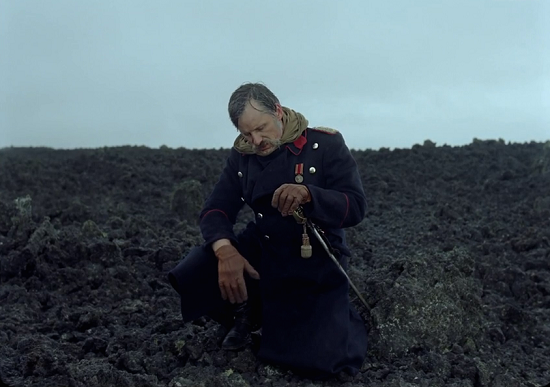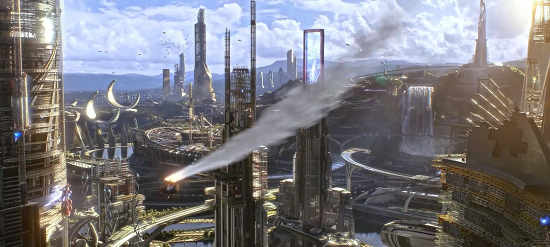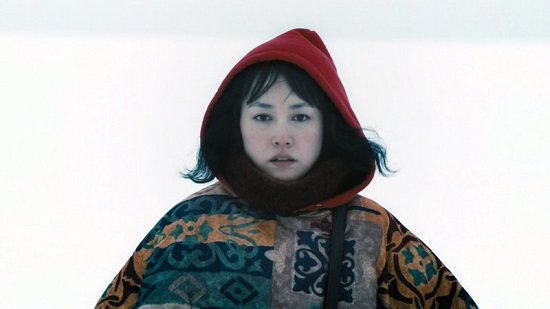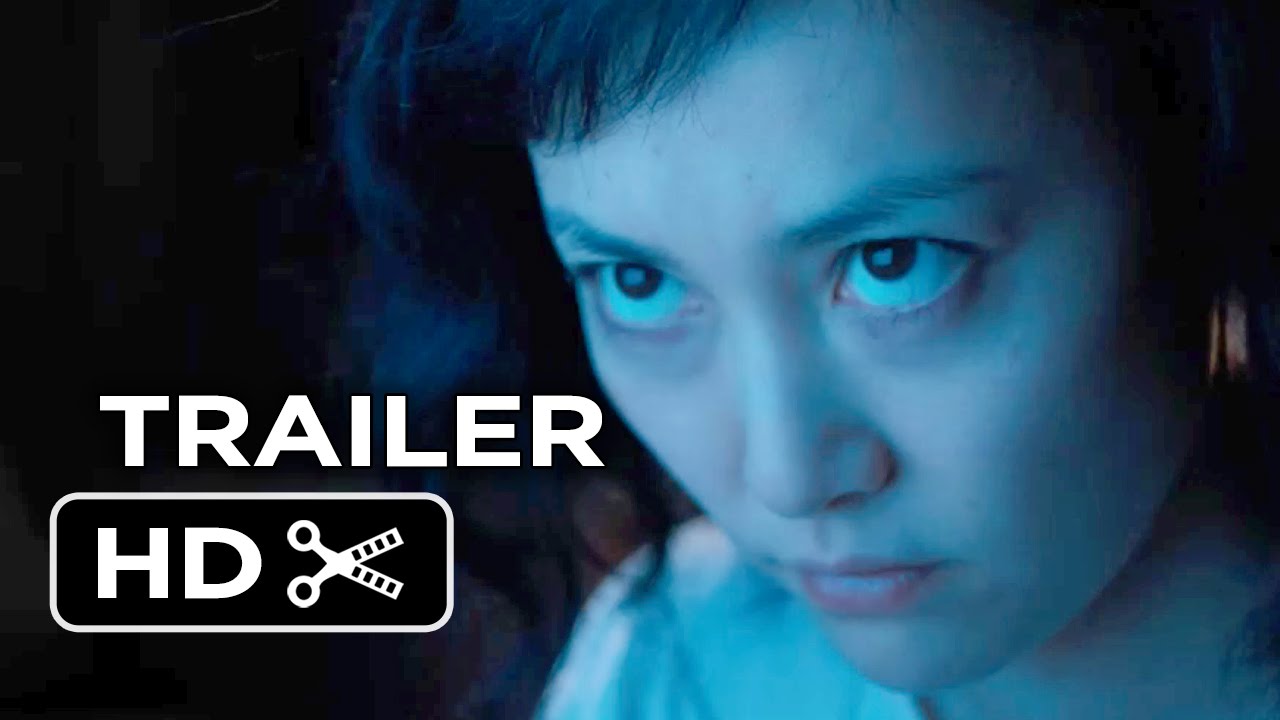The idea of the object is no longer just for artists. Human anxiety about the passing of our material records seems nearly ubiquitous, linked to apprehension about overwhelming connectivity and the changing shape of memory. Between dystopian sci-fi blockbusters and schlocky internet-themed horror movies (Unfriended, anyone?), a handful of recent films explicitly use artifacts with talismanic powers to unite the death of old worlds and the discovery of new ones, implicating the exhaustion of colonial narratives and kicking up questions about gender, magic, and alternate realities to boot.
David and Nathan Zellner’s second feature Kumiko The Treasure Hunter(out on DVD now), reads as an unfinished parable, mythically-charged and magical against the backdrop of contemporary boredom and disorientation. Set in Tokyo and Minnesota/North Dakota, it is a film of little dialogue that deliberately evokes the structure and weight of a folk tale, from Kumiko’s Little Red Riding Hood silhouette to an overtly ominous score. Indeed, the impetus of Kumiko comes from an inherently absurd premise – an unwavering belief in the Coen brothers’ 1996 cult-classic black comedy Fargo and the hunt for its buried treasure. With their peculiar blend of playfulness and gravitas, the Zellner Brothers call upon viewers to imagine a world in which cultural texts become so severed from their original context that they become nearly if not entirely unintelligible, and outdated media objects become fetish.
Kumiko’s (Rinko Kikuchi) quest is set in motion after she digs up a mysterious VHS tape in an ocean cave, an unmarked copy of Fargo which ludicrously functions on her home VCR. Her television is both her source material and light box for tracing the Minnesota landscape where Fargo‘s treasure is buried, which she then embroiders in red thread onto white fabric complete with an X to mark the spot. In a bold and childlike rebellion that no longer quite makes sense, she attempts to steal an atlas from the public library. “Why didn’t you just make a copy?” asks the security guard charged with her punishment. Why not is unclear, but bibliophiles and romantics probably understand. Before leaving Tokyo, Kumiko’s VCR eats up the tape, evoking horror among anyone old enough to remember that kind of devastation. When she replaces it, she buys a DVD from a sterile, florescent-lit shop, the polar opposite of receiving the film from the sea.
Once in Minnesota, she reluctantly accepts the hospitality of good mid-Westerners. At the airport, she is ensnared by two friendly gentlemen offering “tourist information”, and for all the trouble she went to to steal the atlas, she is given a map freely now. The logistics of map-folding is comedy in itself, and as the welcomers point out the route to Fargo, the figurative and literal collapse when their evangelical slant is revealed. Nathan Zellner’s character casually offers, “It’s okay to be lost. I was lost once.” When she is taken in by a widowed housewife (Shirley Venard), the elder woman offers her a worn trade paperback version of James Clavell’s Shogun, along with her thesis on paperback versus hardcover – “Hardcovers are for show-offs.” When she sees Kumiko’s hand-stitched map, she remarks “I like crafts, too!”
Kumiko’s vision of herself as explorer – and conqueror – is central to her quest. “I am like a Spanish conquistador,” she says. The Zellners enact the anthropological idiom of “making the strange familiar and the familiar strange”, up-ending Orientalism in its own way and making both the landscapes of urbanized Japan and midwestern America as much a part of history and legend as anything else. That Kumiko is a lost conquistador is not so much an indictment of her character as it is an open question: what do we do when our stories, artifacts and imperialist narratives alike, rapidly take their place in the shadowy realm of collective memory, where they are subject to damage, loss, and dangerous misinterpretation?
Like Kumiko, Lisandro Alonso’s Jauja deftly dislodges a narrative of conquest, taking on new worlds and evoking profound confusion that symbolically hinges on a single folk object. What starts as a moderately straightforward story of colonialist effort gives way to disintegration on several different planes. An undefined Danish venturer named Gunnar Dinesen (Viggo Mortensen) finds himself in Patagonia with his beautiful, placid-faced daughter Ingeborg (Viilbjørk Malling Agger), who are first presented passing time,rather slowly, amidst the vast tidelands. Like the Zellners, Alonso employs sparse landscapes, minimal dialogue, and lingering camera work for an otherworldly atmosphere that borders on fairytale.

Alonso quickly establishes an intense father-daughter intimacy between Gunnar and Ingeborg, who is the object of desire for both the brutish commander Pittaluga and the young, silent assistant Corto. Idling together by the ocean, Corto finds a small wooden soldier and naturally gives to Ingeborg. Later in the evening, Ingeborg rummages through her father’s possessions and pockets his compass, a now-antiquated tool that was once cartographic necessity. When Gunnar awakens to find that Ingeborg has absconded with Corto, his panic manifests in comical attempts to dress himself in a sequence poking fun at masculine military masquerade. Ingeborg’s departure gives way to the major action of the film: following Gunnar in his increasingly hopeless, delirious trek into the desert in search of his lost daughter.
Both the pretense of claiming Patagonian territory and any real hope for recovering Ingeborg fall away as Mortensen clownishly, tipsily, scrambles among the rocks. The film’s archetypal bent is undoubtable when Gunnar takes refuge in a cave, where he encounters a witchy elder who cackles and makes cryptic conversation that very strongly suggests both Gunnar and the viewer are no longer dealing in conventional notions of time and space. Amidst the bizarre exchange, she inexplicably produces Gunnar’s stolen compass. Gunnar stumbles out of the witch’s cave and deeper into existential void. Without giving too much away, Ingeborg’s wooden doll re-emerges as an essential vehicle that confirms Alonso is exploring not just the colonial New World but new worlds full of alternatives to linearity – and perhaps more female agency than we bargained for.
Aside from the explicit use of the doll artifact in representing both loss and parallel universes, Jauja itself references the visual technology of the past. Filmed in 35mm with a 4:3 aspect ratio and rounded corners, each frame looks like a singular, old-fashioned photograph, an effect that is all the more emphasized by the bold colors and saturated scenery. Leo Goldsmith writes for Reverse Shot that the film “coyly harkens back even further than classical Hollywood or silent cinema, and to pre-cinematic attractions like the panorama and early landscape photography.”
Disney’s Tomorrowland is a stark departure from the independent meditations of Alonso and the Zellners,offering a mainstream chime-in to the fixation on changing media technology and envisioning new worlds. Instead of directly implicating colonial histories, the film only goes as far back as 1964, when protagonists Frank Walker (Thomas Robinson/George Clooney) and “Athena” (Raffey Cassidy) first meet at the New York World’s Fair, which was particularly rooted in American concepts of progress and included most major American manufacturers of the time, including, incidentally, some of the first computer technology available for the public to interact with. Athena takes a shine to Frank at the fair and offers him a small, retro pin with an emblazoned “T” that is literally his ticket to the future. Fast-forwarding to the present day, viewers meet the intrepid Casey Newton (Britt Robertson) who mysteriously finds an identical pin among her effects, and finds it immediately transports her to Tomorrowland when she touches it – an effect that only works for her.

When the pin stops working, Casey goes AWOL to visit a spacey memorabilia shop. Surrounded by various past-future collectibles, the owners lust after her pin and turn out to be less than benevolent. Athena comes to the rescue, and Casey’s wild goose chase to figure out what exactly is going on brings her to Frank Walker the Elder’s doorstep. The interior of his home is chock full of bizarre future-centric souvenirs, including a sort of holographic stereoscope reboot. After some hard-earned ingratiation, Casey, Frank, and Athena travel to Tomorrowland to try to recover the future. Here, we learn that Frank invented a technology that could show images not only of the past but of the future, and through some sort of mishap (it gets a little hazy here), the public became subconsciously aware of a projected negative future and implicated in a self-fulfilling prophecy of apocalypse. Whether deliberate or not, Disney makes a fairly valid point about the potential desensitizing effect of the proliferation of horrific media, be it through television, internet, or Frank’s tachyon-vision-machine.
Tomorrowland‘s heavy-handed conclusion results in a re-issuing of the pins, and what had become a scarce talisman becomes new again. Casey and Frank rally together a fresh crowd of young idealists, who are instructed to go out and find the next batch of inventors and visionaries. The propaganda-esque finale witnesses a curated and diverse selection of young scientists, musicians, etc. discovering their pins and arriving together in Tomorrowland, populating a golden field that looks upon the city of the future.
For their many differences, it is fascinating what Kumiko, The Treasure Hunter, Jauja, and Tomorrowland have in common: female-driven stories centred around the search for new worlds, which rely heavily on the fetishistic power of seemingly innocuous material relics endowed with magical capabilities. Collectively, they do not offer solutions but instead are laboratories for reflecting particular anxieties about bidding farewell to old worlds of thought.



